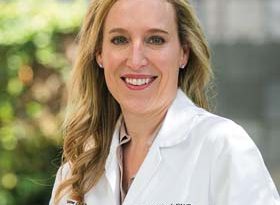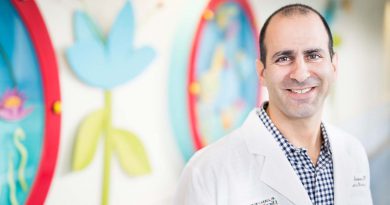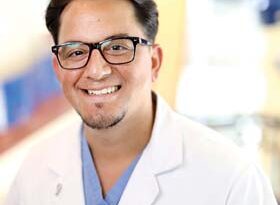Pioneers of Hope
Published on June 7th, 2019 by Christina Echegaray.
Summer 2019
At Monroe Carell Jr. Children’s Hospital at Vanderbilt, our work extends beyond patient exam rooms. We are also searching for discoveries to offer better treatments, provide quality care and train the next generation of clinicians. The profiles here represent only a sampling of the tireless work performed daily to make Children’s Hospital a place of unwavering hope. In each issue, we also include a profile to highlight our longstanding partnership with our community pediatricians who help ensure all children receive the best care each and every day.

In 1985, Elizabeth “Betsy” Triggs, MD, applied for a position with Green Hills Pediatrics. If accepted, she would become not only the first female pediatrician in the long-established practice, but also the first female pediatrician in private practice in west Nashville.
She had worked with Joseph Lentz, MD, one of the founding partners of the esteemed practice, during her fellowship and he offered her the job. The other three male partners needed a little convincing.
“The guys took a chance on me. They didn’t know if anybody would want to see a woman doctor. I think they thought this is the future; moms are going to want to see some women doctors, and this might just work,” Triggs recalls. “They were hesitant; they didn’t know if I was going to stay working, because a lot of women (at the time) stopped working when they had children, and I was pregnant with my first child.”
Thirty-four years later, Triggs, the senior partner at Green Hills Pediatrics, counts among her patient population the children of patients she saw when she started practicing.
“It’s more than just the intellectual part; it’s being part of the family, but also part of the community. I love that I know what’s happening locally in business and in banking and in the schools. My partners and I end up knowing about all the different local schools. We might know who an outstanding math teacher is and also might know who the impossibly tough one is. We end up knowing a lot about the community, and all of that is important for the kids’ health — behavioral, mental and physical.”
Triggs earned her undergraduate degree from the University of North Carolina and her MD from the University of Mississippi School of Medicine. She did her pediatric residency and behavioral and developmental fellowship at Vanderbilt University Medical Center. Her ties to Nashville and to Vanderbilt are strong.
“Being in private practice, it is such a luxury to have a world-class children’s hospital right down the street. It’s just amazing to know that we’ve got back-up and it helps me sleep at night. We have all these wonderful specialists, subspecialists and emergency room physicians at our disposal should we need them,” Triggs said of Monroe Carell Jr. Children’s Hospital at Vanderbilt.
Triggs is past president of the Cumberland Pediatric Foundation, a member of Tennessee Women in Medicine, the Tennessee American Academy of Pediatrics and the national American Academy of Pediatrics.
She and her husband, Austin, have two grown children. Her daughter, Elizabeth Triggs Tipton, and her husband live in Nashville. Triggs counts spending time with her granddaughter, Louise, among her favorite pastimes.
“It is such a joy to watch my daughter be a great parent,” she said.
She enjoys walking the Percy Warner Park trails and participates in a book club with Vanderbilt residents, faculty and private practice attending physicians. Her son, Andrew, is a pitcher for the Oakland Athletics, and she attends as many of his games as possible.
She gets as much enjoyment from her job now as she did when she first began. She has observed increasing stress and anxiety among parents and their children, but her approach to their care remains steadfast.
“I love to talk with kids at their visits, be it about Legos, Harry Potter, YouTube videos or sing Baby Shark with them,” Triggs said. “I also love educating parents about the developmental stages all kids go through and let them know that they are universal. No child is a Terrible Two forever.”
– by Kathy Whitney
• • •

As a child in Western Pennsylvania, Chris Bonfield, MD, loved playing with Transformers and other toys that could be taken apart and reassembled. He liked tinkering with structures and science.
Foreshadowing his career in his high school yearbook, Bonfield wrote he’d be a neurosurgeon, although he’s certain today that his younger self didn’t fully understand what that meant.
In fact, neurosurgery isn’t as clear cut as it seems. While some neurosurgeons treat brain tumors, epilepsy and hydrocephalus (water on the brain), others, like Bonfield, specialize in areas such as the bones of the skull and the spine.
Bonfield, director of Pediatric NeuroSpine and Neurosurgery Craniofacial Programs, treats about 200 pediatric cases and 80 adult cases a year and tackles craniofacial surgery, pediatric spinal deformity and scoliosis correction as well as complex spine reconstructions in adults.
Early in medical school, he realized he liked the science and surgery of the spine and brain, but the field is so rigorous that students are advised to explore other areas before committing. While on rotation in his fourth year at University of Pittsburgh School of Medicine, he reconfirmed his path.
“The layperson hearing ‘neurosurgery’ thinks you’re slicing into brains all the time, and yes, we do that. When I’m on call I take brain tumors out of babies and do other things inside the brain — it just so happens that a lot of my interests are deformed bones and correcting those to help the brain grow and the spine function normally,” said Bonfield.
Bonfield, who came to Vanderbilt in 2015, enjoys rounding on patients at Monroe Carell Jr. Children’s Hospital at Vanderbilt because it is anyone’s guess as to what the children will say. There’s also a fun element in being able to do follow-ups in clinic that don’t involve shots, and where children get to give him high- and low- fives so he can observe their movements.
Pediatric patients also do well with recovery and often have positive outcomes, which may be seen less often in adults with some neurosurgery conditions, he notes.
“We have serious conditions that we can actually fix in children. They heal better so they can come back from brain tumors and bad head injuries, and a lot of them do well — not just OK. That goes missed by people — the chance to get some really incredible wins,” he said.
If he’s not at work in Children’s Hospital, Bonfield is probably on a plane. Since his first trip abroad in college to Greece, he’s traveled to more than 80 countries. He and his wife, Stefany, like to take weekend trips to explore new neighborhoods and flavors.
“Often, we don’t have anything planned for when we get there. It’s just a chance to explore and see something new,” Bonfield said.
He also frequently travels to countries such as Tanzania and Peru, where people have little, if any, access to neurosurgery.
In 2013, Tanzania, a country that’s twice the size of California and home to more than 50 million people, had four neurosurgeons, all located in the same hospital. The surgeons also lack resources and manpower to execute many basic neurosurgery procedures.
Bonfield has helped train general and orthopaedic surgeons to do routine neurosurgery procedures that can be lifesaving.
He has also established connections for other VUMC neurosurgeons. The chair of his department, Reid Thompson, MD, went with Bonfield on one trip and has gone back to lead a group on his own.
“It’s having friendships with the local doctors and having colleagues overseas you’re working with to teach and to learn from them. It’s helping bring skills to more people, so they can improve the quality of life of their patients. We’re trying to take what we’re learning here and going global to educate others,” said Bonfield.
– by Holly Fletcher
• • •

Pediatric infectious diseases specialist Ritu Banerjee, MD, PhD, is an only child of Indian immigrants — postdoctoral researchers who from their home on Long Island commuted to labs in New York City. Her father worked on cholesterol biosynthesis, while her mother focused on reproductive endocrinology.
The family had no relatives in the U.S., so staying in touch entailed some long voyages.
“One of the most impactful experiences I had as a child was going to India when I was 8, and seeing the poverty and the disparity in wealth, and I recall from that time wanting to do something to aid public health,” Banerjee said.
Having discovered interests in science and music early on, she grew up studying violin, and as a teenager worked summers in research labs. Banerjee initially planned to double-major, but instead focused on the biology curriculum at Swarthmore College in Pennsylvania, playing in orchestras and chamber groups on the side.
At Washington University in St. Louis, she completed the MD-PhD Medical Scientist Training Program, focusing her dissertation on malaria-causing microparasites and how they survive in the red blood cells of human hosts.
“At the end of my PhD, I went back to do some of my clinical rotations to finish out the MD, and I realized I really like spending time with patients. Having been in the lab for several years working on a single gene, I just said to myself, ‘For future research questions I really need to do something more translational, something that bridges discovery in the lab to actual care of patients.’”
Banerjee’s research has since tended toward clinical epidemiology, antimicrobial stewardship and implementation of rapid diagnostics for infectious diseases. After residency and a fellowship at the University of California San Francisco and seven years on the faculty at Mayo Clinic in Rochester, Minnesota, she joined Vanderbilt in 2016, becoming associate professor of Pediatrics, director of the Pediatric Infectious Diseases Fellowship Program and director of the pediatric arm of the Vanderbilt Antimicrobial Stewardship Program (VASP).
The World Health Organization and the Centers for Disease Control and Prevention (CDC) have deemed antibiotic/antimicrobial resistance a major public health threat. Antibiotic resistance is a consequence of the use of antibiotics in health care and agriculture. Rampant misuse is dangerously worsening the problem, with prescribing practices continuing to vary wildly across the world and across the United States. Tennessee’s antibiotic prescribing rate is among the nation’s highest. The CDC’s latest summary estimates show that in 2013 there were 23,000 deaths in the U.S. due to antibiotic and antifungal resistance.
“We’re increasingly faced with extremely drug-resistant pathogens, the superbugs that we hear about in the news. You have to treat them with combinations of drugs that are less effective and more toxic than our standard therapy, so outcomes are worse and health care costs are higher,” Banerjee said.
“Drug-resistant bacteria are emerging and spreading faster than we’re developing new drugs to treat them. We are running out of effective antibiotics to treat some of these strains, so it’s really important as clinicians that we use our existing antibiotics judiciously and responsibly,” she added.
Under VASP, inpatient use of antimicrobial drugs at Monroe Carell Jr. Children’s Hospital at Vanderbilt has decreased 51 percent since 2012. Inpatient orders for certain broad-spectrum antimicrobials require sign-off by an infectious diseases specialist. Teaming with infectious diseases pharmacist Jessica Gillon, PharmD, Banerjee practices “handshake stewardship,” meeting with health care teams across the hospital to discuss individual cases. Assisting the program at Children’s Hospital is Infectious Diseases Clinical Fellow Sophie Katz, MD, who will soon join the faculty. Banerjee and Katz are working with the Cumberland Pediatric Association on a program to advance antimicrobial stewardship at pediatric clinics across the region.
Banerjee and her husband met as grad students working in the same lab at Washington University. Andrew Kloek, PhD, works for a health care consulting firm. They have two daughters, Kareena, 11, and Anisa, 13.
– by Paul Govern
• • •

Kate Copeland, RN, MSN, hails from a family of teachers, and other than a stint as a candy striper as a teen growing up in East Tennessee, nursing wasn’t top-of-mind as a career choice.
When she was offered an academic scholarship to pursue a nursing career at Tennessee Technology University, she took a chance — and fell in love. Nearly four decades later, nursing, for Copeland, has become more a passion than a job, focusing to ensure children have access to compassionate, quality care.
“I found I loved taking care of patients. It didn’t matter which clinical rotations I did, I loved it all — adults and children,” said Copeland, administrative director of Emergency Services for Monroe Carell Jr. Children’s Hospital at Vanderbilt.
She was drawn to the neonatal intensive care unit and believed she would be caring for the youngest, sickest patients. When she graduated with a Bachelor of Science in Nursing, she began working with adult patients, hoping to eventually move toward a job in pediatric nursing.
In 1991, after several nursing jobs working with adults, Copeland decided to relocate to Nashville, where she was born. Upon learning the city had a children’s hospital — then located within Vanderbilt University Adult Hospital — she applied for the opening and got the job, first as a staff nurse and then as a charge nurse. At that time, the pediatric units at Vanderbilt, designated to three floors, had a varied case mix, with children needing chemotherapy to those having respiratory illness.
“I knew this was where I needed to be,” Copeland recalls about starting out. “I love taking care of all children. There wasn’t one area I liked more than another, and I enjoyed the versatility of all the patient cases. We took care of all pediatric illnesses on the floor.”
After 10 years of caring for some of the sickest children, Copeland was ready to explore a different area of pediatric health care, joining the pediatric Emergency Department (ED) in 2001— about three years before the freestanding Monroe Carell Jr. Children’s Hospital at Vanderbilt opened.
She admits the fast pace and variety of illnesses and injuries of the emergency department caught her by surprise at first, and she questioned her abilities.
“There was so much I didn’t know. Soon, I became comfortable. I loved the team work and the different sets of dynamics,” she said. “You see people in their most stressful time of life as a child and parent and you get to intervene to help them. You get sad cases, but you see patients you get to help, with broken arms or other illness, injuries and they get to go home. There is a quick pace, but you can make a difference.”
Copeland worked her way up to a charge nurse position in the ED, and onto an assistant manager, then manager before moving into her current role as administrative director. Her focus is always on the patients and the families.
“Patient experience is something I am very passionate about. Quality and access are very important,” she said. “We offer the very best pediatric care here at Monroe Carell Jr. Children’s Hospital, without a doubt, and I want to ensure every child has access to that care — not only for emergency services but across all our specialties.”
When Copeland is not at work, she enjoys cheering on the Nashville Predators hockey team and visiting her daughter, Jessica Spencer, and son-in-law, Richard, in Austin, Texas. One of her proudest moments was the arrival of her new grandson, CJ, who was born in February.
– by Christina Echegaray




